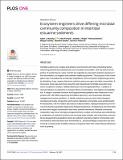Files in this item
Ecosystem engineers drive differing microbial community composition in intertidal estuarine sediments
Item metadata
| dc.contributor.author | Wyness, Adam J. | |
| dc.contributor.author | Fortune, Irene | |
| dc.contributor.author | Blight, Andrew J. | |
| dc.contributor.author | Browne, Patricia | |
| dc.contributor.author | Hartley, Morgan | |
| dc.contributor.author | Holden, Matthew | |
| dc.contributor.author | Paterson, David M. | |
| dc.date.accessioned | 2021-02-22T14:30:01Z | |
| dc.date.available | 2021-02-22T14:30:01Z | |
| dc.date.issued | 2021-02-19 | |
| dc.identifier | 273007650 | |
| dc.identifier | ac3d9afe-8e82-430c-8340-d389d8861ee6 | |
| dc.identifier | 85101365341 | |
| dc.identifier | 000620629200004 | |
| dc.identifier.citation | Wyness , A J , Fortune , I , Blight , A J , Browne , P , Hartley , M , Holden , M & Paterson , D M 2021 , ' Ecosystem engineers drive differing microbial community composition in intertidal estuarine sediments ' , PLoS ONE , vol. 16 , no. 2 , e0240952 . https://doi.org/10.1371/journal.pone.0240952 | en |
| dc.identifier.issn | 1932-6203 | |
| dc.identifier.other | Jisc: 07d7f44d8d2549a197ad84f7a320d5b2 | |
| dc.identifier.other | publisher-id: pone-d-20-31006 | |
| dc.identifier.other | ORCID: /0000-0003-1174-6476/work/89627980 | |
| dc.identifier.other | ORCID: /0000-0002-9665-8813/work/89628057 | |
| dc.identifier.other | ORCID: /0000-0002-4958-2166/work/89628090 | |
| dc.identifier.uri | https://hdl.handle.net/10023/21475 | |
| dc.description | Funding: This work was funded by the John Templeton Foundation Grant 60501, “Putting the Extended Evolutionary Synthesis to the Test”. It also received funding from the MASTS pooling initiative (The Marine Alliance for Science and Technology for Scotland, (https://www.masts.ac.uk)) and their support is gratefully acknowledged. MASTS is funded by the Scottish Funding Council (grant reference HR09011) and contributing institutions. DMP received funding from MASTS, funded by the Scottish Funding Council (grant reference HR09011), and AJW received funding under the MASTS small grant scheme (grant reference SG433). | en |
| dc.description.abstract | Intertidal systems are complex and dynamic environments with many interacting factors influencing biochemical characteristics and microbial communities. One key factor are the actions of resident fauna, many of which are regarded as ecosystem engineers because of their bioturbation, bioirrigation and sediment stabilising activities. The purpose of this investigation was to elucidate the evolutionary implications of the ecosystem engineering process by identifying, if any, aspects that act as selection pressures upon microbial communities. A mesocosm study was performed using the well characterised intertidal ecosystem engineers Corophium volutator, Hediste diversicolor, and microphytobenthos, in addition to manual turbation of sediments to compare effects of bioturbation, bioirrigation and stabilisation. A range of sediment functions and biogeochemical gradients were measured in conjunction with 16S rRNA sequencing and diatom taxonomy, with downstream bacterial metagenome function prediction, to identify selection pressures that incited change to microbial community composition and function. Bacterial communities were predominantly Proteobacteria, with the relative abundance of Bacteroidetes, Alphaproteobacteria and Verrucomicrobia being partially displaced by Deltaproteobacteria, Acidobacteria and Chloroflexi as dissolved oxygen concentration and redox potential decreased. Bacterial community composition was driven strongly by biogeochemistry; surface communities were affected by a combination of sediment functions and overlying water turbidity, and subsurface communities by biogeochemical gradients driven by sediment reworking. Diatom communities were dominated by Nitzschia laevis and Achnanthes sp., and assemblage composition was influenced by overlying water turbidity (manual or biogenic) rather than direct infaunal influences such as grazing. | |
| dc.format.extent | 20 | |
| dc.format.extent | 1522106 | |
| dc.language.iso | eng | |
| dc.relation.ispartof | PLoS ONE | en |
| dc.subject | Research Article | en |
| dc.subject | Earth sciences | en |
| dc.subject | Research and analysis methods | en |
| dc.subject | Biology and life sciences | en |
| dc.subject | Physical sciences | en |
| dc.subject | Ecology and environmental sciences | en |
| dc.subject | GC Oceanography | en |
| dc.subject | QE Geology | en |
| dc.subject | QR Microbiology | en |
| dc.subject | DAS | en |
| dc.subject.lcc | GC | en |
| dc.subject.lcc | QE | en |
| dc.subject.lcc | QR | en |
| dc.title | Ecosystem engineers drive differing microbial community composition in intertidal estuarine sediments | en |
| dc.type | Journal article | en |
| dc.contributor.institution | University of St Andrews. Scottish Oceans Institute | en |
| dc.contributor.institution | University of St Andrews. School of Biology | en |
| dc.contributor.institution | University of St Andrews. Sediment Ecology Research Group | en |
| dc.contributor.institution | University of St Andrews. Infection Group | en |
| dc.contributor.institution | University of St Andrews. School of Medicine | en |
| dc.contributor.institution | University of St Andrews. Biomedical Sciences Research Complex | en |
| dc.contributor.institution | University of St Andrews. Infection and Global Health Division | en |
| dc.contributor.institution | University of St Andrews. St Andrews Sustainability Institute | en |
| dc.contributor.institution | University of St Andrews. Coastal Resources Management Group | en |
| dc.contributor.institution | University of St Andrews. Marine Alliance for Science & Technology Scotland | en |
| dc.contributor.institution | University of St Andrews. St Andrews Bioinformatics Unit | en |
| dc.identifier.doi | 10.1371/journal.pone.0240952 | |
| dc.description.status | Peer reviewed | en |
This item appears in the following Collection(s)
Items in the St Andrews Research Repository are protected by copyright, with all rights reserved, unless otherwise indicated.

